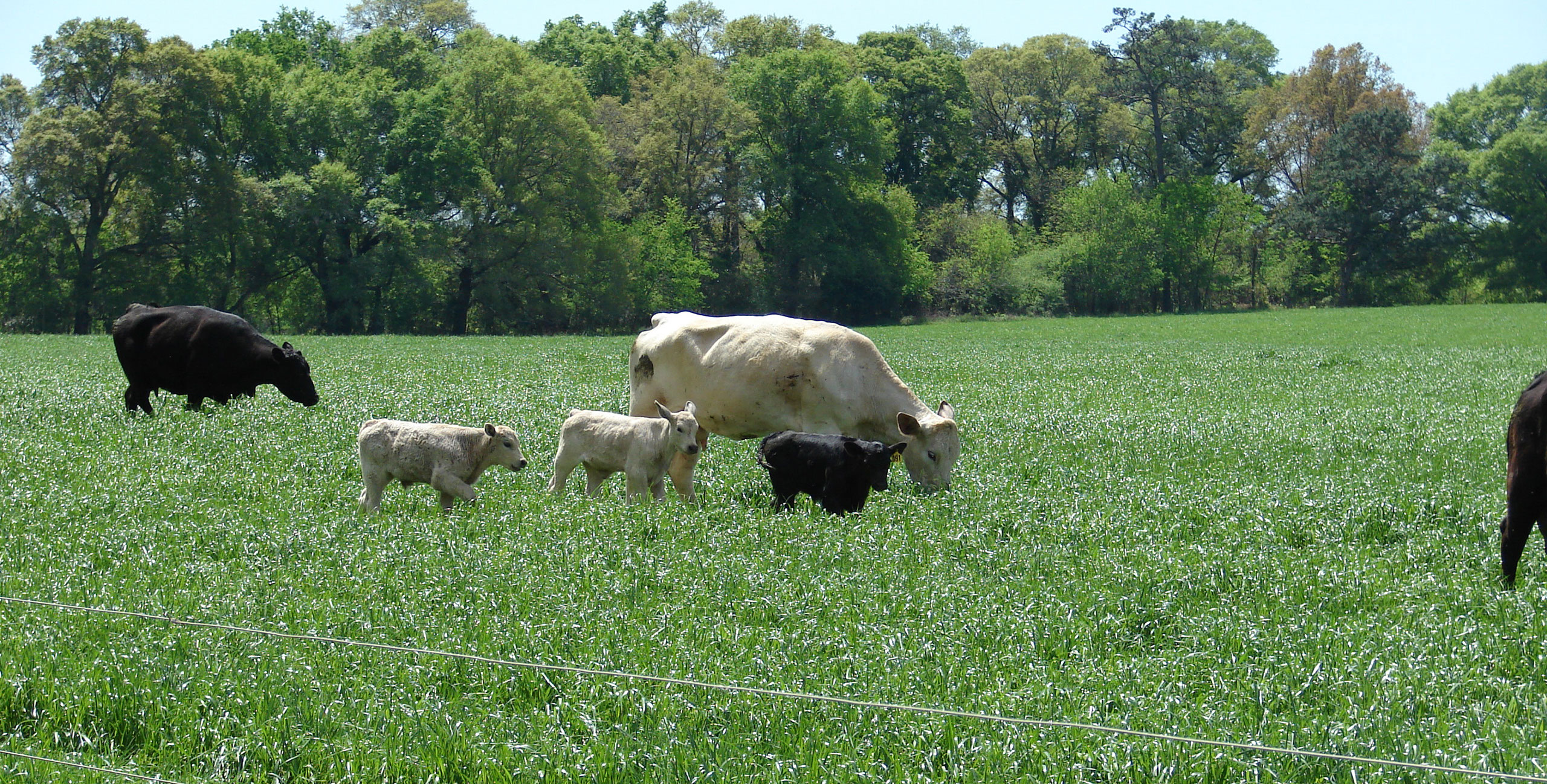Introduction
Sod-based rotation is a systems approach to sustainable agriculture which uses naturally occurring plant-soil interactions to reduce production inputs and increase yields. The key component of the project is the incorporation of perennial grasses into a row crop production system which ultimately results in an increase in soil organic matter.
Sod-based rotation was developed by researchers at the University of Florida’s Institute of Food and Agricultural Sciences via funding from federal, state, and commodity grants. This is a multi-state cooperative project across state and federal agencies which has research sites in Alabama, Florida, and Georgia.
This project has delivered a viable production system for small farms in the 100 to 1000-acre range. These farms include family farms, as well as a large number of minority and presently under-funded farmers. Larger farms will also benefit from the project outcomes.
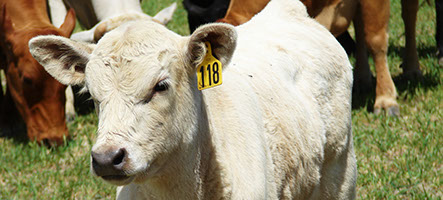
Economics
Economic models developed thus far indicate that a 200-acre farm can increase its net profit from less than $50,000 per year, under the present peanut-cotton-cotton rotation, to over $90,000 per year with the sod based rotation which is bahiagrass for 2 years with cattle then peanuts and then cotton.
This simple spread sheet model can be used by interested producers to see how their particular farming operation may benefit from a bahiagrass rotation with either cattle or hay production as compared to a conventional cotton-peanut cropping system.
Impacts
The impact of the project will be significant throughout the southeastern United States, especially in the rural communities that are still dependent upon farm production and other natural resources. This system will significantly enhance profitability of row crop production in the Southeast by increasing yields while decreasing production costs. It will reduce runoff and increase water and nutrient use efficiency due to greater rooting depth and root mass of the row crops following bahiagrass. Finally, incorporating bahiagrass into the rotation will break harmful pest cycles (plant parasitic nematodes, insects, pathogens, and weeds) and thereby reduce the need for many pesticides.
The increased farm profitability would create jobs in smaller rural towns making them a viable place for young people to stay, live, and work.
The System
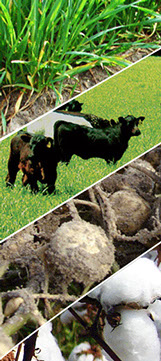
THE SYSTEM
•The sod based rotation system involves planting bahiagrass for two years (and/or incorporating livestock, primarily cattle, for the second year), rotating to peanuts for one year, followed by cotton the next year, and then returning to bahiagrass with winter cover crops each year.
•Main production limitations in the Southeast are infertile, compacted, droughty soils, and pests. There is an economical way to markedly reduce the impact of each of these limitations, and that is by using a sod based rotation of bahiagrass or Bermuda grass in the cropping system.
•The sod based system incorporates conservation tillage and enhances its many beneficial effects including: protecting against soil erosion, increasing soil moisture holding capacity, and reducing pesticide use.
*click icons on the left to explore elements of The System
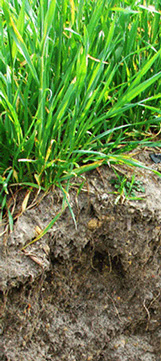
BAHIAGRASS
•Much of the farmland in the Southeast suffers from a hardpan layer starting at 6-9 inch depth and continuing to 24 inches. The key with sod based rotation is to get a perennial grass into your cropping system, where two-thirds of the biomass is below ground in roots. After bahiagrass, there can be a 30-40% increase in crop roots down to a soil depth of 5 feet.
•The use of bahiagrass in rotation with row crops has numerous advantages leading to increased yield. The increased root depth and density will make the row crops more efficient at extracting deeper water and increased water infiltration will reduce the need for irrigation in row crops.
•Bahiagrass pasture also may benefit from rotation. Permanent grass pastures are not as productive as pastures plowed and seeded periodically. By rotation with row crops, there is the opportunity to control weeds that may have invaded the pasture and replant new or different varieties of grass.
•The warm-season bahiagrass grows on all soil types and resists drought.
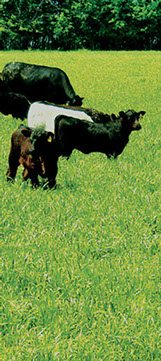
CATTLE
•Cattle can be introduced into the system during second year of bahiagrass which differs from conventional systems where cattle and crops are often separated.
•The cattle can graze the grass and control weeds. If row crops cant be sold because they’ve been damaged by hail, floods, or drought, farmers can still salvage some value from them by using them as cattle feed.
•The biggest benefit cattle offer is nutrient recycling. When farmers spread large quantities of stored manure on fields once a year, substantial amounts of ammonia nitrogen are lost through volatilization, and unincorporated nutrients can runoff into nearby waterways. Livestock, on the other hand, deposit manure continuously in small amounts that improve the soil rather than overwhelming it.
•It is estimated that cattle can provide 50% of crop nutrient needs by recycling nutrients through manure and urine, reducing both the need for commercial fertilizer and the likelihood of potential runoff.
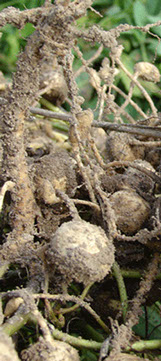
THE SYSTEM
•The sod based rotation system involves planting bahiagrass for two years (and/or incorporating livestock, primarily cattle, for the second year), rotating to peanuts for one year, followed by cotton the next year, and then returning to bahiagrass with winter cover crops each year.
•Main production limitations in the Southeast are infertile, compacted, droughty soils, and pests. There is an economical way to markedly reduce the impact of each of these limitations, and that is by using a sod based rotation of bahiagrass or Bermuda grass in the cropping system.
•The sod based system incorporates conservation tillage and enhances its many beneficial effects including: protecting against soil erosion, increasing soil moisture holding capacity, and reducing pesticide use.
*click icons on the left to explore elements of The System
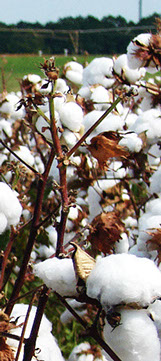
COTTON
•Cotton is also a major cash crop of the rotation system.
•Growers expect a 50 to 100% increase in yield in cotton after bahiagrass.
•As with peanuts, the major factors in this increase in yield are a reduction in plant pathogenic nematodes and greater water and nutrient use efficiency owing to an increase in rooting depth and root mass of cotton. There is also the potential added benefits from increased organic matter in the soil.
•Cotton after bahiagrass is additionally known to exhibit less stress during dry conditions and take up more nitrogen.
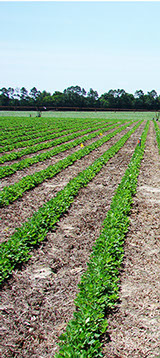
Conservation Tillage
•Conservation tillage is critical to the system, in addition to protecting against erosion and potentially boosting profits, no-tillage and strip-tillage are known to reduce the incidence of disease in cotton and peanut, conserve soil moisture, and help root and foliar development in these crops. While bahiagrass can pose challenges with reduced-tillage practices, killing the bahiagrass in the second year prior to frost and planting a winter cover crop will allow bahiagrass roots to decompose before peanuts are planted.
Production Aspects

PESTS
By incorporating cultural control strategies into the row crop production system, the integrated pest management of several plant pests will be dramatically altered.
•Second, the bahiagrass reduces the need for nematicides on cotton and peanuts.
•Finally, the use of herbicides may be reduced because of the pasture-row crop rotation not allowing any specific weed to reach pest levels. This is especially important when morning glory or pig weed becomes a problem in glyphosate resistant crops. Due to the reduction in total area treated and the reduction in what is applied to a specific area, we expect that the pesticide load on an individual farm will be 25% less for fungicides, 100% less for nematicides, and 50% less for herbicides.
•Glyphosate resistant weeds are not a problem in the rotation because only one resistant crop (cotton) is used during the 4 year rotation and other herbicides are available during the grass phase.

WATER
•In traditional rotation systems in the Southeast, it is very difficult to effectively manage water stress because the hard pan prevents deep penetration of the water and plant roots.
•Under these conditions, water has to be applied frequently, increasing labor and equipment costs.
•After bahiagrass there can be a 40 fold increase in crop roots down to a soil depth of 5 feet. This allows for a much larger volume of soil water to be accessed by the crop, increasing water extraction and water use efficiency, substantially reducing the need for irrigation as compared to traditional rotation.
Water extraction is not the only factor dramatically affected by rooting depth. Nutrient extraction is also greatly enhanced when rooting depths are increased, especially nitrates. Greater rooting depth not only increases the use efficiency of fertilizers applied, but also decreases the potential for contamination of groundwater with nitrates and other farm chemicals.
FUTURE APPLICATIONS
•The incorporation of perennial grasses into cropping systems is being successfully developed in other areas using cool weather (fescue and orchard) and tropical (star) grasses. There is also studies proving the value of perennial grass in organic vegetable production. Finally, there is interest in the application of this concept in low acreage systems using goats and or poultry as the herbivore component.
Resources
PAPERS
- Soil Organic Carbon Dynamics in a Sod-Based Rotation on Coastal Plain Soils By A. Gamble, J. Howe, C. Wood, D. Watts, & E. Van Santen
- Impact of Grazing on Soil Properties and Cotton Yield in an Integrated Crop–Livestock System By S. George, D. Wright, J. Marois
- Cattle Grazing Affects Cotton Root Dimensions and Yield in a Bahiagrass-based Crop Rotation By R. Loison, D. Rowland, W. Faircloth, J. Marois, D. Wright, & S. George
- Sod Based Rotations M. Fisher
- Improved Growth and Nutrient Status of an Oat Cover Crop in Sod-Based Versus Conventional Peanut-Cotton Rotations By D. Zhao, D. Wright, J. Marois, C. Mackowiak, M. Brennan
- Peanut Yield and Grade Responses to Timing of Bahiagrass Termination and Tillage in a Sod-based Crop Rotation By D. Zhao, D. Wright, & J. Marois
- Comparative Plant Growth and Development in two Cotton Rotations under Irrigated and Non-Irrigated Conditions By T. Katsvairo , D. Wright, J. Marois, J. Rich, & P. Wiatrak
- Effect of Bahiagrass on Nematode Populations in the Field and Their Behavior Under Greenhouse and Laboratory Conditions By F. Tsigbey, J. Rich, J. Marois, & D. Wright
- Cotton Roots, Earthworms, and Infiltration Characteristics in Sod–Peanut–Cotton Cropping Systems By T. Katsvairo, D. Wright, J. Marois, D. Hartzog, K. Balkcomb, P. Wiatrak, & J. Rich
- Performance of Peanut and Cotton in a Bahiagrass Cropping System By T. Katsvairo, D. Wright, J. Marois, D. Hartzog, K. Balkcom, P. Wiatrak, & J. Rich
- Sod–Livestock Integration into the Peanut–Cotton Rotation By T. Katsvairo, D. Wright, J. Marois, D. Hartzog, J. Rich, & P. Wiatraka
- Integration of Perennial Forages and Grazing in Sod Based Crop Rotations By Roger Gates
- Soil Health, Economic, and Water Quality Considerations with the Use of Sod Crops in Corn Based Cropping Systems By T. Katsvairo, W. Cox, & H. Van Es
- The Bahiagrass and Paspalum Breeding Program By A. Blount
- Perennial Grasses, Soil Organic Matter, and Crop Yield By D. Wright & J. Marois
- Impact of Bahiagrass, Cotton, and Corn Cropping Frequency on the Severity of Diseases of Peanut By A. Hagan, H. Campbell, J. Weeks, M. Rivas-Davila, & B. Gamble
- Strip-Till Tomato Production In Bahiagrass Sod By J. Rich, F. Rhoads, S. Olson, & D. Chellemi
- Potential Outcomes of Integrating Cattle and Cropping Systems in Southeastern Major Land Resource Areas By J. Stuedemann, A. Franzluebbers, D. Seman, & D. Wayne Reeves
- Bahiagrass and Other Crops in a Rotational Study to Reduce Nematodes and Other Pests Affecting Peanut Yield and Quality By J. Baldwin, G. Padgett, & A. Johnson
- A Working Business Model for Cattle/Peanuts/Cotton By J. Marois & D. Wright
- The Wright Way: AdvancingSouthern Agriculture from 1977-2022 / Blount
- Resilient Cropping Systems: Pathway for Sustainable Future / Sidhu
- Healthy Soils, Healthy Crops / Mackowiak
- Conservation & Integrated Crop/Livestock Systems: Accomplishments & Aspirations / Love
- Integrated Crop-Livestock Systems: What We Learned and Where We Are Headed / Dubeux
- The Road to Regenerative Agriculture / Treadwell
*Contact a UF associate listed below for access to full-text articles.
Contacts
Ann R. Blount
Professor
Agronomy, University of Florida
[email protected]
Zane Grabau
Assistant Professor
Nematology, University of Florida
[email protected]
Charles Barrett
Regional Specialized Agent
Water Resources, University of Florida
[email protected]
Sunny Liao
Assistant Professor
Soil Microbial Ecology, University of Florida
[email protected]
Wendy Graham
Professor
Water Resources, University of Florida
[email protected]
Nicolas DiLorenzo
Associate Professor
Animal Sciences, University of Florida
[email protected]
Jose Dubeux
Associate Professor
Animal Science, University of Florida
[email protected]
Sheeja George
Biological Scientist
NFREC-Quincy, University of Florida
[email protected]
Cheryl Mackowiak
Associate Professor
Soil and Water Science, University of Florida
[email protected]
James J. Marois
Professor Emeritus
Plant Pathology, University of Florida
[email protected]
Gabriel Maltais-Landry
Assistant Professor
Sustainable Nutrient Management Systems, University of Florida
[email protected]
Andrea Albertin
Regional Specialized Agent
Water Resources, University of Florida
[email protected]
Xavier Martini
Assistant Professor
Entomology, University of Florida
[email protected]
Ian Small
Assistant Professor
Plant Pathology, University of Florida
[email protected]
David L. Wright
Extension Agronomist and Professor
Agronomy, University of Florida
[email protected]
Kris Balkcom
Program Associate
Agronomy and Soils, Auburn University
[email protected]
Julie Howe
Associate Professor
Agronomy and Soils, Auburn University
[email protected]
Scott Tubbs
Associate Professor
Crop and Soil Sciences,
University of Georgia [email protected]



